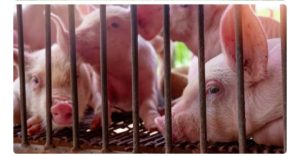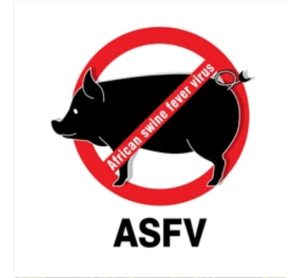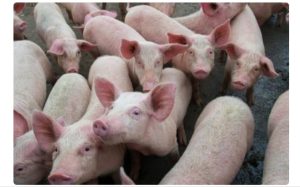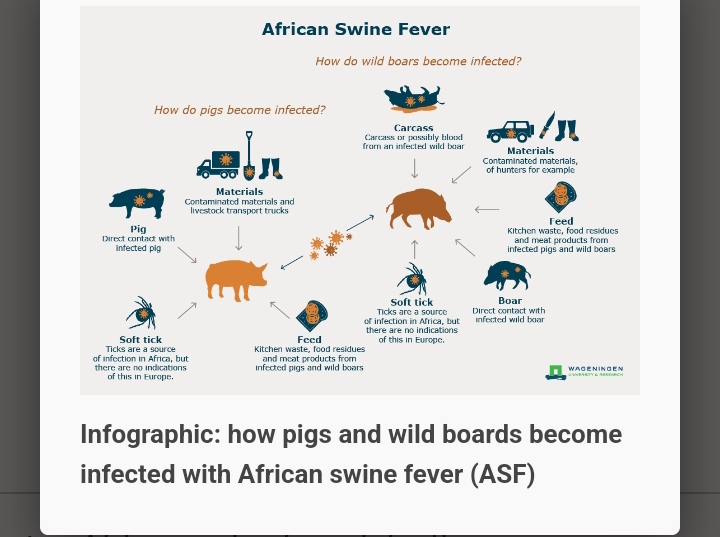Swine fever is a highly contagious viral disease affecting domestic and wild pigs, leading to devastating economic losses in pig farming. The disease is caused by two major viruses: Classical Swine Fever (CSF) and African Swine Fever (ASF). While CSF has an effective vaccine, ASF remains a major challenge due to the lack of a commercially available vaccine or treatment. Understanding the symptoms, preventive measures, and possible treatment options is crucial for controlling outbreaks and ensuring sustainable pig production.
Understanding Swine Fever
Click HERE to join our WhatsApp group
Swine fever can spread rapidly through direct contact with infected pigs, contaminated feed, farm equipment, and even humans carrying the virus on their clothes and shoes. The viruses are highly resistant and can persist in the environment for long periods, making prevention and control a serious challenge for farmers and veterinarians worldwide.
Symptoms of Swine Fever
The symptoms of swine fever vary based on the virus strain, pig age, and immune response. The disease can be categorized into acute, chronic, and subclinical forms.
1. Classical Swine Fever (CSF) Symptoms
Acute Form:
High fever (40-42°C)
Loss of appetite, weakness, and depression
Red or purplish skin discoloration (ears, snout, belly)
Diarrhea or constipation
Convulsions and tremors, especially in piglets
High mortality rate within 10-20 days
Chronic Form:
Persistent low-grade fever
Weight loss and stunted growth
Skin ulcers and secondary infections
Prolonged survival but eventual death
Subclinical Form:
No visible symptoms, but pigs become virus carriers
Virus spreads unnoticed in the herd, leading to outbreaks
2. African Swine Fever (ASF) Symptoms
ASF symptoms are often more severe and lead to higher mortality rates.
Peracute Form:
Sudden death without prior warning signs
High mortality in newly infected farms
Acute Form:
High fever (40-42°C)
Severe weakness and lack of appetite
Red or blue skin patches due to internal bleeding
Bloody diarrhea and vomiting
Swollen joints, difficulty breathing
Death within 7-10 days
Chronic Form:
Prolonged weight loss
Skin lesions and joint swelling
Surviving pigs remain virus carriers, spreading infection
Transmission and Spread of Swine Fever
Direct Contact: Healthy pigs coming into contact with infected pigs.
Contaminated Feed: Swill feeding (uncooked kitchen waste) can introduce the virus.
Farm Equipment and Personnel: The virus can be carried on clothes, boots, and transport vehicles.
Wild Boars and Ticks: ASF can spread through tick bites and wild boar interactions.
Prevention of Swine Fever

Since ASF has no cure or vaccine, prevention is the only defense. CSF, on the other hand, can be managed through vaccination.
1. Biosecurity Measures
Farm Entry Control: Limit access to pig housing to essential personnel.
Quarantine for New Pigs: Isolate newly introduced pigs for at least 21 days.
Disinfection Protocols: Regular cleaning and disinfection of farm buildings, equipment, and transport vehicles.
Rodent and Insect Control: Minimize the risk of virus transmission through external carriers.
2. Vaccination Strategies
CSF Vaccination: Routine vaccination effectively prevents outbreaks.
ASF Vaccination: Currently, no effective vaccine exists, making strict biosecurity the only preventive measure.
READ ALSO: Behaviour differences linked to broiler growth rates
3. Proper Feeding Practices
Avoid feeding pigs with untreated swill or food waste.
Provide high-quality commercial feed and fresh water.

4. Surveillance and Early Detection
Regular monitoring of pigs for symptoms.
Immediate reporting of suspected cases to veterinary authorities.
Testing and culling of infected pigs to prevent outbreaks.
Treatment of Swine Fever
For Classical Swine Fever (CSF):
No direct cure, but supportive care helps improve survival rates.
Antibiotics prevent secondary bacterial infections.
Fluid therapy maintains hydration and electrolyte balance.
Vitamin supplements help boost immunity.
For African Swine Fever (ASF):
No treatment available.
Infected pigs must be culled to prevent further spread.
Strict farm lockdown and biosecurity measures to contain outbreaks.
Economic Impact of Swine Fever
Swine fever outbreaks result in severe financial losses due to:
High mortality rates leading to reduced herd sizes.
Trade restrictions and export bans on affected farms or regions.
Increased costs of culling, disposal, and disinfection measures.
Decline in pork supply, leading to market price fluctuations.
READ ALSO: Infectious Bursal Disease(Gumboro) in Poultry
Global Efforts in Swine Fever Control

Research and Vaccine Development: Ongoing studies to develop an effective ASF vaccine.
International Collaboration: Disease control strategies coordinated by organizations such as the World Organisation for Animal Health (WOAH).
Public Awareness Campaigns: Educating farmers on biosecurity and early detection.
Conclusion
Swine fever is a serious disease that threatens pig production worldwide. While CSF can be managed through vaccination and biosecurity measures, ASF remains a major challenge due to its high mortality rate and lack of a vaccine. Prevention through strict biosecurity, proper feeding practices, and surveillance is the most effective strategy to protect pig herds from these devastating diseases. Farmers must remain vigilant and work closely with veterinary authorities to minimize risks and maintain sustainable pig farming.
READ ALSO: Best Ways to Avoid Mortality in Brooding
The top performance indicators to validate an excellent result in brooding are:
Uniform growth of birds
Not more than 2% mortality
If you are having challenges in any of these, then you need to check out these ten main tips which can help…
READ ALSO: Water Quality and Its Impact on Poultry Health
Water quality is a crucial factor in poultry production, directly influencing bird health, growth, and overall farm productivity. Contaminated or poor-quality water can lead to disease outbreaks, reduced feed conversion efficiency, and economic losses for poultry farmers. This article explores the importance of water quality in poultry farming, the key contaminants…
Click HERE to join our WhatsApp group

